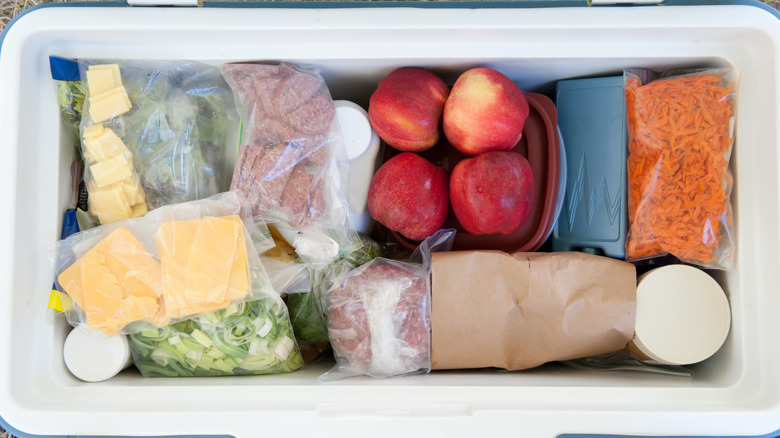The Right Way To Use A Cooler This Summer
We may receive a commission on purchases made from links.
The days are heating up and that means that it's time to pack some delicious food and get out of the house for a good time. But before you throw caution to the wind and load your cooler willy-nilly, know that there is actually a way to use and pack a cooler like an expert — if you want food that's safe to eat, that is. Most of us are fans of warm weather. Unfortunately, so are bacteria. In fact, temperatures between 40 and 140 degrees Fahrenheit are perfect for bacterial growth. This means keeping your cooler cold is paramount.
If you pack your cooler and find there's a lot of empty space left, fill that empty space with nonperishable food items. A full cooler stays cold longer than a partially filled one. It won't hurt your jar of peanut butter to ride in the cooler with the cold food even if the peanut butter itself doesn't need to be kept cold. When placing your items in the cooler, make sure to put perishable items closer to the ice, but keep beverages closer to the top or in a separate cooler entirely since people are likely to open the lid more often for a beverage. Opening the lid as little as possible is a great way to trap the cold air inside. Bonus points for finding a shaded spot for the cooler to rest while everyone enjoys the weather.
Tips for packing your cooler with safety in mind
Once you've got your cooler packed and transported, keep in mind how long food stays safe to eat in a cooler. When perishable food is taken out, it should be placed back inside within an hour if the outside temperature is 90 degrees Fahrenheit or higher. If the ice in your cooler is melting, it may be smart to make a run to get some more because if a cooler heats up beyond 40 degrees, perishable contents may become unsafe to eat. You can monitor the temperature in your cooler with an appliance thermometer.
If you're packing a cooler with dry ice instead of regular ice (the best way to keep popsicles frozen in a cooler) make sure not to pack anything you don't want rock solid, as dry ice is much colder than regular ice. It also melts (or rather, evaporates) faster, so make sure you're using dry ice in a well-ventilated area. Another safety tip for dry ice is never to touch it with your bare hands as it will hurt you. Use gloves, tongs, or a rag. Packing a cooler with food safety in mind prevents illness and keeps food delicious so you can spend more time enjoying the weather.

